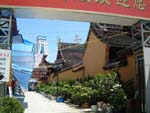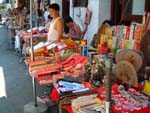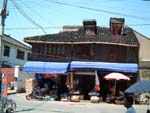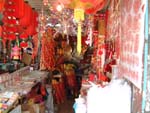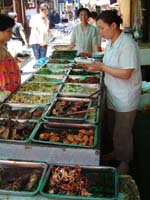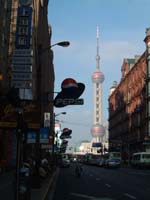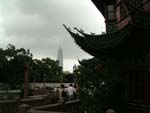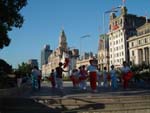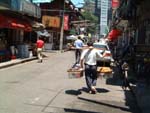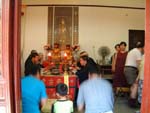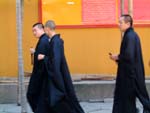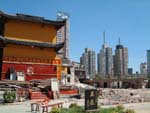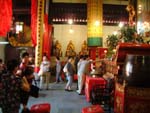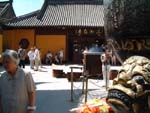Published John Wiley & Sons - 2002
CHAPTER 4 - British Shanghai::
Alan Balfour
The transformation of Shanghai and eventually China was the result of the threat of war by a superior force - the British Navy - not seeking to destroy, but to open the way for peaceful invasion. It was as if the Chinese navy had a blockaded Hamburg until Germany allowed China to develop a wholly Chinese port city next door. The invasion may have been peaceful but its objective was power and control, from China the Britain would consolidate its domination of world trade.
In deciding to develop a port on the Huangpu River the British took the name of what was in their view as an insignificant town close to the land they were to develop. In the first decades of the settlement neither the reality of Chinese Shanghai nor of China was of any concern to the invaders.
By the late 18th century the British were the major foreign traders along the China coast. Tea was the principal commodity. While trading between China and its neighbours involved simple tariffs paid to customs officials, foreign trade was managed by the so-called Canton system - the channelling of all Western trade through Canton by imperial decree, and the payment of obligatory tax as a tribute to the emperor. This greatly angered foreign traders, particularly the British. Even before transactions were possible, a mission had to travel to Beijing, and the representatives of the nation seeking a trading relationship had to prostrate themselves before the emperor, the 'Son of Heaven'. Taxes were collected through Chinese merchants in Guangzhou called the Hong (or Cohong for combined merchant companies), who had the power to set the price for imports and exports, and collected duties and tariffs for the Qing administration.
British trade was under the control of the British East India Company, whose business interests stretched across Asia and who supported its expansion with a large, well-trained military force. The British used the profits from opium grown in India, which it illegally traded with the Cohong, to offset the tribute they were paying to the imperial administration on tea and cotton. This process cultivated a huge appetite for the drug, and pushed China's balance of payments from a strong surplus in 1826 to a deficit of 40 million Yuan in 1838. During this period, Western manipulation of the cotton trade caused the core of the Shanghai economy, the international market in the indigo-dyed cotton, nankeen, to collapse.1 The major problem for China was Western resistance to handling Chinese currency, and increasing competition in the price and quality of cotton from British and US mills. The collapse of the nankeen trade created an overall depression, which led to disruption of the southern trade routes caused by trade disputes. In a short space of time, China was forced to exchange its previous status as the major exporter of finished cotton for a role as the major importer of goods and cloth from the UK and US. The British took advantage of the much-weakened Shanghai. The collapse of the nankeen trade and the subsequent economic depression greatly aided their prosecution of the Opium War.
The Opium War (1839-42)
The Chinese government's efforts to end opium smuggling and the British merchants' resentment of the Canton system were the major ingredients for the war. On 19 June 1841, a double column of British ships towing men-of-war, steamed up the Huangpu to anchor alongside Shanghai. At the same time, an artillery regiment came ashore on the estuary of the Yangtze and moved on the city over land. Such was the force of the advance that the Chinese guns, on the ramparts to the north of the city, were never even fired. There was such fear of the approaching foreigners that the whole population, including the imperial officials and the military, fled the city, leaving the British to enter without resistance. They made their headquarters in the Yu Yuan Gardens, and although a British letter written during the occupation described the gardens as 'extensive and built in good style . . . [with] many summer and grotto houses . . . affording quarters for the soldiers', in only five days of occupation the British army demolished the exquisitely carved garden pavilions for use as firewood. The city had not been so violated since the raids of the Wukou pirates. In those five days there was much looting and plundering, a reported rape, and several people killed.
British naval power overwhelmed Qing forces. They took control of the major ports north to Guangzhou, and when the British moved on Nanjing, the emperor sued for peace. The result was the Treaty of Nanjing. The treaty, signed in 1842, established most of the trading freedoms that had been sought in the first British mission to China in 1793. It led to the opening of the four 'Treaty' ports of international trade in addition to Canton, and established British Shanghai.
The articles of agreement were as follows:
. An indemnity to be paid to Britain by China of 21 million Mexican silver dollars as compensation for war expenses, opium confiscated by the Chinese government, and debts owed by the Cohong merchants in Guangzhou to British merchants. (Britain had already received six million dollars as ransom for the opium that had been confiscated by Lin Zexu, the Qing commissioner.)
. The opening of the five so-called Treaty Ports of Guangzhou, Xiamen, Fuzhou, Ningbo and Shanghai for foreign residence and trade.
. The abolition of the Cohong and the establishment of a moderate fixed tariff on imports and exports, which China could not alter without British consent.
. The granting to Britain of most-favoured-nation treatment by China, meaning that Britain would automatically be given any privilege that China might later extend to any other nation.
. The appointment of foreign consuls at Treaty Ports, who would be able to communicate directly with officials of equal rank in the Qing government. This included the principle of extraterritoriality in civil and criminal cases. British consuls would have jurisdiction over British subjects accused of crimes or involved in disputes with Chinese citizens. British citizens would be tried by the Consul under British law, while Chinese citizens would be tried under the laws of China. This principle, exempting the British from Chinese laws, violated China's judicial powers.
. The cession of Hong Kong, a barren island near Guangzhou, to Britain in perpetuity. Under the Convention of Beijing, in 1860 China also ceded Kowloon, on the mainland across from Hong Kong, to Britain. In 1898 Britain acquired a 99-year lease over the New Territories adjoining Kowloon. Hong Kong, Kowloon and the New Territories reverted to China in 1997.
The British Parliament revoked the East India Company monopoly on trade in 1843. Thus the British government became directly responsible for trade and for the development of a power-base in China. When the first British delegation arrived in the city, it was led by the newly appointed Consul, Captain George Balfour, as the representative of the British plenipotentiary in Hong Kong. Out of respect for the significance of the occasion, Consul Balfour was met by Senior Administrative Gong Mujiu, Intendant of the Susongpang Circuit, and tariff collector for the entire region. Shanghai was declared open as a Treaty Port on 18 November 1843.
Why did the British choose Shanghai? Hugh Hamilton Lindsay was the first to explore the city's trading potential for the East India Company.3 He arrived in 1832 with an interpreter and called it the principal emporium of Eastern Asia. In 1843 the Hong Kong Legislature described it as 'containing at least 300,000 souls'. He reported that in addition to Chinese shipping, vessels came to Shanghai from Singapore, Malacca, Penang, Java, Sumatra, Borneo and cities surrounding the Persian and Indian seas, and from as far as the isles of Polynesia. At a parliamentary enquiry in 1847 investigating the potential for trade with China, Consul George Balfour argued the case for the city. First, he cited its proximity to Suzhou and the Chinese interior. It was, he argued, 'destined to become the great Emporium for the China trade'. His reasoning was primarily based on a belief that Shanghai's strategic location, close to the mouth of the Yangtze, would let British trade penetrate the interior of China, gaining access for British goods to a population in the hundred millions (a familiar tale).
The difference between an imperial capital such as Beijing - utterly conservative and ordered to maintain an absolute and unchanging authority - and the informal structure of trading cities such as Shanghai, was sufficiently extreme to lead to the emergence of quite distinct urban cultures. Those within imperial control lived with numerous constraints on freedom and expression not enforced in Shanghai. At a fundamental level, those living under imperial domination formed highly conformist and conservative societies, both insular and xenophobic. Those living in the competitive, diverse trading cities on the coast were opposite in almost all respects. It would have been inconceivable for a great European city to emerge on the edge of Beijing. It was only in the resilient informality and expediency of Shanghai that such a disturbing growth could have been tolerated. (Beijing itself had been occupied by European forces after the sacking of 1806, and by the end of the 19th century the commercial district south of Tiananmen Square had acquired a distinctly European character. Even today, a self-conscious Victorian clock disturbs the view south from the tomb of Mao Zedong.)
Article 2 of the treaty stated that cities and towns should be opened to British subjects, where they might reside for the purposes of carrying out mercantile pursuits without molestation or constraint. This was read by the British to mean the right to live within the city - an interpretation never accepted by the Chinese. At first the Shanghai administration treated the British as just another foreign trading group, viewing their needs and demands as equivalent to requests from the Native Place societies. China was a land of many peoples with distinct languages and ethnic traditions, and Ningbo, Shaoxing and several others all had their own Huiguan north and east outside the walls of the old city. The Chinese imagined that all the British needed was the equivalent of a Native Place Huiguan - a compound within which to conduct their business and house their people.
Although British records describe the difficulties of finding temporary accommodation within the city, in these first months Consul Balfour insisted on, and was successful in establishing, a consular office inside the walls of Shanghai, close to the great red tower of the Duguan Customs House that dominated the river's edge. According to Chinese documents, the first request made by Consul Balfour was for land on which to build their Huiguan. Senior Administrative Gong Mujiu gave the British 'a piece of wasteland' to the north of the city. This 'wasteland' contained a mixture of small farms, craft workshops, silk weavers, cotton furnishers and dyers, wood carvers and candle makers and most significantly the Huiguan of the Fujian and Ningbo merchants, which had been established in 1796, and had evolved into a complex of meeting halls, temples and mortuaries, all of which the British and subsequent foreign incomers would have to remove.
The Balfour Plan
It was Consul Balfour who administered the laying out of the settlement's master plan, a plan that would establish streets, quays and river frontage within the agreed boundaries - the west bank of the Yangtze to the Yangtze Creek at the southern end and close to the Wusong River (Suzhou Creek) at the northern end. In the first years of settlement the major trading merchants had strips of land along the river's edge, and later the Consulate moved from within the walled city to the strategic and prominent stretch of land to the north, at the confluence of the two rivers, which had been the site of the major Chinese fortification in the defence of Shanghai from attack from the Yangtze.
Balfour's plan for the city was very simple, and even today the informal alignments of the major streets show that it was not a work of military surveying, although Balfour had been a captain in the Indian army. The plan he achieved was an imperfect grid, neither straight nor parallel, with each of the major sections varying in width. This was not the result of artistic licence, but derived from the continual struggle to reconcile the new plan to the previous uses and paths in the area, and to come to agreement with a patchwork of Chinese owners, all with differing demands and all resentful of the foreign presence. However, it is of interest that this informality had typified the form and character of Shanghai since the earliest times. From the old paths that ran along the river's edge, three roughly parallel major streets were laid out, running westward, and cut by two transverse streets that formed six, roughly similar rectangles of developable land. All major streets led to the waterfront, along which the great trading houses gradually established their operations and eventually built their palaces. The plan also included sites set aside for the European cemetery, the church, and that essential element in all colonial cities, the racetrack.
The scale of the resulting plan is very European and, from the beginning, the overall texture was utterly different from the dense circumstantial order of the Chinese city. The same six rectangles still form the heart of the foreign city. The plan, however, was not implemented without many years of struggle. Many different owners, tenant farmers, craftsmen and small-scale manufacturers, occupied much of the so-called wasteland. Most sensitive of all was the fact that there were numerous family tombs in the area, involving careful negotiation to remove the graves in releasing the land for development. The British, it was felt, did not respect the significance of these grave sites, whose positions had been carefully established by geomancy - an issue complicated by the British wish to own, not lease, the land. This led to highly inflated prices and claims against the British, and in the end the Shanghai authorities had to establish a set price for all acquisitions. Both issues were symptomatic of the tensions and divisiveness that were embedded in the foundation of Shanghai's foreign concessions.
Along with planning the town, Balfour's most formal achievement was the Land Regulations of 1845: 'This code, which has been subjected to numerous revisions .. defines the boundaries of the settlement, provides for the acquisition and lease of lands (originally in perpetuity from the Chinese), defines the qualifications of electors, who must be landowners or taxpayers, and otherwise provides a structure for administrative government.'9 Balfour also reached agreement on the rules for foreign anchorage, which from the beginning defined the way in which the British city would grow. It established 'The place of anchorage for loading and unloading as close over as possible to the left bank, at the bend of the (Huangpu) river adjacent to Wusong [Creek], which is at a distance of three quarters of a mile below the walls of Shanghai.' The site within which the foreigners could trade and evolve was immediately adjacent to the foreign anchorage.
The Chinese administration mapped the newly established foreign area in 1846. The document shows nothing of the old city save the walls and moat enclosing the northern half, the interior a blank save for the Customs House and Yu Yuan Gardens, the only places that could have any significance for the foreigners. The new settlement is well to the north of the old walls and separated by the creek that flows from the Suzhou to the Huangpu. A path runs straight from the North Gate to the European settlement. On the plan, it appears to be enclosed by a fortified fence. An older road runs from the Chinese port, bridging into the settlement close to the river. In contrast to the absence of any attempt to indicate paths and roads in the Chinese areas, the road pattern of the settlement is carefully and fully set out, each road marked by parallel lines. The only major road through the Chinese area is defined by the outline of buildings that line its route. The plan indicates that there is only one route available to foreigners visiting the old city, a route that leads directly to the Customs House.
A European map from 1855 illustrates that this was a fairly ambitious town, given that it was just over ten years old. Yet it was a town without any apparent connection to the Chinese city, on the left of the map. The names of the European streets betray neither pride nor personality, are called after neither administrators, politicians nor businessmen as one might have expected. But this is a practical town given to practical names; the major routes back from the river are called Mission Road, Customs House Road and Ropewalk Road. The only hint of romance comes in the name Park Lane, a central street that ends in a little park that survives to this day. This would later be renamed Nanjing Road, in celebration of the treaty. At the northern end, Consulate Road runs by the Consulate. Transverse roads are equally practical - Church Street, Bridge Street, Barrier Road - naming use very much in the Chinese manner.
The strangest map of the period, from around 1853, shows the 'Shanghai Walled City', and the 'English Ground', with a tiny patch of 'French Ground' squeezed between, and, well to the right, the 'American Ground'. It appears to reflect accurately on the major element of the new settlement but shows a city filled with Christian missions and chapels. These make the settlement palatable to a prospective visitor from the West, and were presumably to show the extent of missionary work among the heathens ( one wonders what American missionaries what of there own cities at this time particularly New York and the plan to create a great park.)
The United States acquired the right to trade in the Treaty Ports on 3 July 1844, followed closely by the French on 24 October. The French had established a political base in Canton in 1776, and in 1843 their envoys signed a convention establishing a trade relationship with China. On its ratification, France's new Consul, Theodore Layreine, arrived in China in the company of Roman Catholic prelates, proudly waving from the prow of a gunboat. Though this was a relationship based on commerce, the French never lost sight of the larger project - to pursue with China an agreement that would equal the commercial and diplomatic advantages enjoyed by Britain. In these negotiations, a significant clause (Article 22) protected French churches and missions. This was aligned with imperial decrees from 1844 and 1846, which allowed the Chinese to practise Christianity. It also allowed, the French argued, for the restoration of property confiscated during an imperial crackdown on foreign religions in the 18th century.
Across China, French interests were closely allied to those of the Roman Catholic Church, and Article 22 led the French to claim several parcels of land around the city - sites of Catholic buildings constructed in the Ming Dynasty. These included a small lot just inside the walls of the old city and a large tract of land in the southern suburbs that had been the site of the first Catholic mission. Work quickly began on this southern site on the construction of a cathedral for a Chinese congregation, and the new Consul found accommodation within this French property in the old city; for him, it was a little piece of France.
With the expansion of the settlements, the Chinese believed that the British Consul should manage all Westerners, but the French would have none of it. After persistent negotiation over a period of years, and a threat from gunboats, France was granted exclusive tenure to the French settlement in Shanghai.
By 1846, 24 merchant firms, three of which were American, were in operation in the international concession. There were by this time five retail stores, 25 private residences, a church, a hotel, a dispensary, a clubhouse at the racetrack, and the first burials in the cemetery. In this same year, the committee on roads and jetties was set up to oversee the construction of the Bund (they used the Hindu name meaning embankment or dyke). It is of interest that during these early years, citizens formed these private voluntary organisations to initiate and carry out public works, which in England would have been the responsibility of the municipality - exactly the same shift from public to private altruism that had so changed Shanghai in the first decades of the 19th century. In both cases, merchant culture underpinned a system whereby major institutions in the city were supported by a self-governing, self-taxing financial structure combined with a belief in public service. However, compared to the tens of thousands of merchants in Chinese Shanghai, the foreign population was in the low hundreds.
The Taiping Rebellion and the Small Sword Society
Just ten years after its foundation, the character of this fragile foreign settlement would be shaped by events that were affecting all of China. The Taiping Rebellion was the largest and most damaging uprising anywhere in China during the Qing Dynasty. It had a deep impact upon the structure and stability of the nation, and a direct effect on the growth and evolution of Shanghai. The leader, Hong Xuiguan, was a Hakka, and part of a subgroup of the Han, with a distinct language and customs. Though born poor, his ability allowed him to receive a public education, although he failed in the Civil Service exams. As a young man in Guangzhou he was given pamphlets on Christianity, written by the first Chinese convert to Protestant Christianity, and these were the source of the revelation that came to him several years later - that he was the younger brother of Jesus Christ and had been commanded by God to destroy all pagan idols and bring the Chinese people to the true God. After a brief period of Christian study in Guangzhou with an American missionary, he drew attention to his claims by destroying ancestral tablets in neighbourhood Confucian temples. Moving north to Jiangsu Province, he began to attract converts to his movement, the Worship of God Society. It was particularly attractive to minorities, such as his own Hakka people. Within three years it is estimated that he had more than 30,000 followers. By July 1850, the Society had become sufficiently strong to confront the regional forces of the Qing army. As word of his increasing power spread, impoverished peasants and unemployed labourers joined the ranks. In 1851, Hong Xuiguan proclaimed himself leader of a new imperial dynasty, Taiping Tiangu ('Heavenly Kingdom of Great Peace'). Hong would share power over his kingdom with five other kings, one of whom he named general of all his forces.
The Christian ideals on which Hong's vision was based led to policies of vast revolutionary change. Peasants would own the land they farmed, and money, food and clothing would be shared equally. All the cultural and social practices that had caused such pain to the majority of Chinese - slavery, concubinage, arranged marriages, foot binding, legalised torture, prostitution - would be eliminated. In his kingdom, men and women were strictly separated, yet given equal roles in all aspects of society, from war to bureaucracy.
By 1852, the kingdom had amassed an army of sufficient force to march through Hunan Province to the Yangzi. In the spring of 1853 Taiping forces captured Nanjing, former capital of the Ming and southern capital of China. They renamed it Tianjing ('Heavenly Capital'). By 1855, its forces had control over 600 walled towns and cities. Though they established a strong power base, the Taiping were never able to take the Qing capital in Beijing and gradually, in the last years of the decade, imperial forces began to push back.
The Christianity of the Taiping was seen by many both within and outside China as an adoption of Western values. As the rebellion spread, many Westerners gave implicit support to the movement and were openly hostile to the Qing administration. The leading English-language newspaper in Shanghai the North China Herald called the Taiping the 'Nanjing Patriots'. Beijing was particularly concerned by the visits foreigners were making to the Taiping capital, Nanjing, including those by the US envoy and British Consul in Shanghai. Although there was no evidence of it in public documents, the imperial administration suspected that the foreigners were negotiating with the revolutionary government against the Empire.
Over several years the Taiping did establish an effective government and their eventual failure came from the collapse of leadership rather than defeat by the inept Qing army. Its founder, Hong, became increasingly reclusive. Yang, one of his chosen kings, plotted his overthrow, but was assassinated, causing in the process the murder of thousands of Hong's followers. This so disgusted the military commander that he abandoned the movement, leaving a demoralised and divided army and a leaderless revolution, yet this peasant-ruled dynasty survived several more years, such was the appeal to the masses of its ideals.
In 1860, to renew the struggle, the Qing emperor appointed a new commander of the anti-Taiping forces and commissioner for Taiping-held territories. That winter the Taiping army, marching on Shanghai, was halted by an unprecedented snowstorm that left more than three feet of snow across the region, an act of nature that spared the city the massive destruction that the war had caused to Nanjing and the nearby Suzhou. In the last years of the rebellion, the Western powers actively supported the Qing armies. Imperial troops assisted by Western forces formed 'The Ever Victorious Army', led by the American, Frederick Ward Townsend. The struggle was a complex one, and Townsend was killed in battle in 1862, his place taken by the Englishman Charles George Gordon. The sympathy that the West had at first shown faded as the movement became increasingly capricious and uncontrollable. In the end, commitment to help end the revolution was based on the greater benefits to the West in maintaining a malleable and decrepit Qing Empire than in sustaining an unstable revolution. Imperial and Western forces defended both Chinese and Western Shanghai. The British were again quartered in the Yu Yuan Gardens around the City Temple and in native compounds in the old city.
The fight for control of the Shanghai region continued intermittently from 1860 until the revolution collapsed four years later. Shanghai was never taken, but was transformed by the political destabilisation in the region and the vast movement of refugees that flocked into the two cities. Imperial and Western forces laid siege to Nanjing in May of 1862; a siege that lasted for two years and ended in 1864 after 15 days of continuous attack, bringing to an end the Taiping revolution. The surviving Taiping king committed suicide the month before the fall of Nanjing. The leadership refused to surrender and fled the city, only to be hunted down and executed in the months that followed. During the 14 years of rebellion, over 30 million people had been killed.
The movement, however, would be a great inspiration to Mao Zedong and a powerful influence on the evolution of revolutionary politics in China into the 20th century. The palace home of Hong in Suzhou remains a major revolutionary tourist site. But recent scholarship portrays the Taiping revolutionaries as typically bourgeois with strong feudalist tendencies, who, had they succeeded, would have reinstated the dynastic structure. Perhaps this is just one more stage in the continual reassessment of the Mao Zedong legacy. The experience of the Heavenly Kingdom of Great Peace and the force that religion can exert in stimulating the masses to revolution have had a fundamental influence on Chinese political thought up to the present day.
The Small Sword Society
Early in the rebellion, from 1853 to 1855, Shanghai was facing a related revolution of its own. the Small Sword Society, a branch of the Triads, rebelled against the Qing administration within the Shanghai region. The Small Sword Society was founded in 1850 and drew its membership from artisans and unemployed sailors, many of whom were disaffected by the economic impact of increasing foreign trade within the city. Its leader, Lui Lichuan, spoke some English, was effective in dealing with foreigners, and also professed an interest in Christianity. As the Taiping rebellion grew in strength, the Small Swords infiltrated the city militias formed to defend Shanghai from the Taiping. In September 1853 the Small Swords captured the city and during the following months occupied other cities in the region. Once their position was consolidated, they aligned both their military strategy and their political cause with the Taiping Revolutionary Government, which by then had established its capital in Nanjing. For both political and military reasons, the Small Swords carefully respected the independence of the foreign settlements and limited their occupation of Shanghai to the Chinese city.
The Western community, though publicly neutral, gave significant private aid to the Society; at the height of its influence, over 40 Westerners were employed in the Shanghai administration. The Qing administration was particularly concerned that foreign merchants from Shanghai had established trade contacts with the revolutionary government in Nanjing. The struggle to draw the foreign concession - particularly the British - out of their neutrality lasted many months. The Chinese requested that the administration of the international settlement build a trench around the city to interfere with the supply of food and ammunition to the revolutionary government. The French were willing but lacked resources; the Americans were passive; and the British would not commit themselves. The imperial authorities believed that the British were actively supporting the revolution in Shanghai and indirectly showing favour to the Taiping government in Nanjing. The French, however, both by political inclination and because their settlement was on the front line of the conflict, gave full support to the imperial forces against the rebels in the city.14
The British never did commit themselves to opposing the Small Sword Society, and stood by while the French made an all-out attack in January 1855, with a mixed force of French sailors and Chinese imperial troops. This was repelled by the militia of the Small Sword Society with the help of many British and American sailors; all of whom, it was later claimed, were deserters. The foreigners were able to use small arms with much more effect than the Chinese forces on either side. However, the idea of Westerners fighting Westerners across the wall of the old city embarrassed the British into changing their position slightly; they helped blockade the flow of supplies into the old city and arrested British naval deserters, though there was never clear British support for the Qing forces. The rebellion ended in 1855 on the eve of the Chinese New Year, when imperial troops invaded the city from the West. The many diverse members of the Society quickly dispersed and faded back into the narrow lanes of the city.
In the first decades of the international settlement, Chinese who were not the servants or employees of the foreigners could not live within the concession. (The majority of the Chinese employees came not from Shanghai but from Canton, and believed themselves superior and different from the Shanghainese.) In the ten months during which the Small Swords controlled the city, large numbers of refugees poured out of the old city into the foreign concessions, a movement that began to break down the strict division between white and native towns that characterises so many colonial cities.
The Small Sword rebellion was over by the beginning of 1856; the Taiping revolution would last eight more years. In the spring of 1859, the second wave of refugees began to impact on both Chinese and Western Shanghai. Thousands of people fleeing Taiping invaded all parts of the city, willing to pay any price to feel safe. From 1859 until 1864, Shanghai was under constant threat. The militias were digging in, fortifying positions throughout the city. Refugees were flowing uncontrolled into the already overcrowded neighbourhoods and into the settlements. To those living in the city, both Chinese and Western, they were like waves of locusts devouring their way into the tissue of both cities and consuming everything in sight. Although this caused many problems, it created an economic boom in Shanghai and forced the convergence of Chinese and Western interests. The law of 1845, forbidding the Chinese from renting property in the international settlement was wholly undermined by this flood of refugees. During the 1850s, the foreign authorities revised the law without even consulting the beleaguered Chinese administration, making it legal for Chinese to live in the settlements and allowing foreigners to be actively involved in the development of real estate, even though they never had ownership of the land. Shanghai records of 1853 show 500 Chinese in British Shanghai. By the spring of 1864, 20,000 people had settled in temporary huts and in houseboats along the Huangpu River within the settlement.
Fortunes were made in land speculation in the construction of dense, cheap accommodation, sold at inflated prices, the profits for foreign investors exceeding all other major trade, including opium. These were basic wooden houses in crowded rows, warrens of tiny rooms, each housing several families - reportedly with 16 people to a room that was no more than 50 metres square. (The resulting squalor and the continual danger of fire led the authorities to ban wooden constructions in 1870.) This invasion caused much disquiet among the foreign population, who accused the Chinese of petty crime and rudeness, and led to the establishment of a police force, which the British staffed with loyal Sikhs from India. It also led the British to attempt to remove the Chinese brothels and opium dens, a move strenuously opposed by the French, not on moral grounds, but because the money from taxing such activity was the financial basis of the economy of the French settlement. The boom was over almost as quickly as it began. Within months of the defeat of the Taiping armies in 1864, an estimated two-thirds of the hastily built rental properties in the international settlement, and probably more in the Chinese city, stood empty.
The Rise of the Foreign City
Though the conflicts seriously damaged international trade and the movement of goods for several years, after the rebellion, two Shanghais had clearly formed. To the south, behind the walls and into the dense industrial suburbs, lay the Chinese city; immediately to the north were the gridded streets of the Western settlement, recognisably European with its mercantile palaces freestanding on regular plots of neatly attended land.
Despite the tiny population - in the hundreds in the first decade - the British settlement was the dominant influence on the culture and form of the foreign city. Its pragmatic and rational plan quickly concentrated development between the commercial centre along the Bund and the residential streets leading up to it, with industry limited to the north. The English maps of Shanghai from the 1850s show in great detail the ordered streets, the Bund, the church cemeteries, the British and US Consulates, the Chinese Customs House, and the most important commercial structures. All the buildings in the European city - the homes of the merchants, the churches, clinics and dispensary - sat on discrete pieces of land. Though the maps show the line of the wall that once enclosed old Shanghai, they leave the Chinese city as blank as the interest the Westerners had in the culture they had invaded. The suburbs of the Chinese city are either omitted or defined only by the roads that would be needed by the traders.
Although Balfour negotiated the land for the British settlement and laid out the streets, it was his successor, Rutherford Alcock, who consolidated the terms and boundaries of the concession. He removed the Consulate from within the walls of old Shanghai, first to temporary quarters within the south settlement, and established the permanent Consulate compound on a key location at the junction of Suzhou Creek and the Huangpu. In 1846 the North Customs House was built on the river, physically inside the British settlement, and dedicated exclusively to the administration of foreign tariffs. From then on, Western merchants no longer had to leave the familiarity of their settlements to conduct their business. At this point, these two communities - Chinese and foreign - became increasingly separate. Trade was based wholly on the exploitation of the weak by the powerful.
The great British merchant houses, such as Jardine Matheson and John G Russell & Co, were founded on the opium trade. The magnificent commercial palaces springing up along the Bund were also built from the proceeds of opium. The drug never appeared in Chinese correspondence, nor is it mentioned in British trade records, yet all the editorials in the North China Herald contained weekly records on the prices and qualities of the opium coming to the port.18 The laws of one nation saw opium as a social evil and banned its importation, while the Western traders made it the financial basis of all trade. Opium produced trading practices of spectacular duplicity. Maintaining this activity was seen as significant to two world economies - India depended on it and great merchant fortunes rested on it. The Chinese and British authorities struck an unspoken bargain: opium was kept separate from legitimate trade and not brought into open treaty ports. Instead, opium hulks (Fig. 4) were permanently anchored on the river near Wusong, and the British traders discharged their illegitimate cargo in the estuary before proceeding to Shanghai.
There was no discussion of opium in the records of Consul Balfour. His successor, however, deplored the trade. In a letter to Sir George Bonham in 1848, Alcock wrote that the Chinese view of the opium trade was a major obstacle to Britain's interest in China, since the Chinese (with justification) regarded opium as a poison and saw the British as its producers, carriers and sellers for their own profit, to the undoubted impoverishment and ruin of the Chinese. 'They believed that the British had made war and dictated a humiliating peace in order to maintain the traffic in opium', he wrote.
Not only illegal and deeply destructive, opium, in the central decades of the 19th century, underwrote all the legitimate British trade. Again, to quote Consul Alcock, writing in 1849 in a report to the British Plenipotentiary in Hong Kong, Sir John Bowring:
The import of opium, illegal by Imperial Decree, and therefore officially ignored by the authorities of both countries, more than equals in money value the whole of our exports from China to Great Britain, amounting to some five million pounds Sterling annually, tea having the volume of some 3.5 million, and silk 1.5 million É The opium trade, illegal as it is, forms an essential element, inextricably mixed up with every trading operation between these three countries [Great Britain, India, China].
Opium trade affected not only the health of the Chinese, but also the economy of the region. The fact that foreign traders distrusted the Chinese currency meant that trading was conducted principally in silver, resulting in the vast silver drain out of China and ruinous tax rates on the farmers and peasants in districts around Shanghai - of which there is no record of British knowledge or concern. With cash and silver in short supply, as often happened in Shanghai, actual bulk opium, or drafts on opium holdings, were drawn on local banks as a substitute for silver.
After restoring the extensive damage done during the Small Swords rebellion, the Chinese Shanghai returned, at least on the surface, to its traditional form and activity. The rebellion caused several adjustments in trading practices and the north gate was realigned to meet the roads to the foreign settlement. In the settlement the mercantile palaces and homes had a highly consistent form. They were square, two or three storeys tall, with great hip roofs, and verandas and loggias on the lower floors. The ground floor would often be used for storage, with the offices and residences of the principal officers on the upper floors. There was no fired brick in the Shanghai area, so construction was of wood and sun-dried brick. In the beginning, the style was an elegant and simple Classicism, and as the settlement developed, the architecture began to assume the styles and fashions of Victorian England. The architectural history of the British in Shanghai mirrors the manners of London at its most urbane. Shanghai attracted Western architects, and the British in Shanghai demanded the most fashionable realities from home, as, subsequently, did the French, Americans and, later, the Japanese.
From its first development along the river's edge, the Bund, became the centre of trade. The river bank was raised, the edge consolidated, and a broad path laid down. The width of the river, and the presence of ocean-going ships docking across from the powerful banking and merchant companies, was reminiscent in scale and character of the Thames in central London, both comforting to the British, and perhaps guiding development. Equally significant was British achievement in convincing the Shanghai authorities to mark the difficult channel upriver with buoys, and to allow a lightship to be stationed at the dangerous entrance to the river.
The only irrational element in the plan, something present in every major colonial British city since the 18th century, was the racetrack. This was established within months of the signing of the Treaty of Nanjing and was the first coherent element in the new settlement. Its presence had to do with temptation and desire; an obvious symbol of the fantasy that drove British ambition.
The first racetrack was set out on the most convenient available land to the north, a site that later became the setting for the centre of British rule, the Consular compound. The second location of the track was turned into cheap refugee housing in the 1860s. The final location, far distant to the west of the Bund, was laid out and ready for the fall meet of 1861. It evolved into the social heart of the British city in China (and was subsequently reformed at the end of the 20th century to become the People's Square of this great Communist city). As it grew, it changed from a field of exercise and competition for young males to the social centre of the expatriate community, gambling being the ruin of many of them. The imported horses, often collapsing from the heat, were ridden with great expertise by slender young Chinese jockeys.
The ostensible reason for having a racetrack was to provide exercise for the young men staffing the government and mercantile offices of the settlement. But this is hardly an adequate explanation for such an elaborate and costly business. The maintenance of one's horses was an exclusively aristocratic activity in Britain. Ownership of horses for pleasure was, and still is, limited to the wealthy. Most of the early arrivals from England to this illusory culture, would have come from the new middle classes emerging from the cities and industries created by the Industrial Revolution. The racetrack formed a symbolic landscape which afforded the sensation of entering into aristocratic orders and values to those servants of the distant outposts of Empire. Along with the promise quickly acquiring wealth and an aristocratic lifestyle, proved irresistible to the many from the rising middle class. Though different in form and not so destructive, it was like opium, in sustaining dreams and fantasies.
Many clear-eyed writers have attempted to convey the character of these two cities. At the turn of century, a 68-year-old English woman, Isabella Bird, wrote a book entitled The Yangtze Valley and Beyond, published in 1899, which begins with her visit to Shanghai. It is of interest that at the time of her visit, just 50 years after the foundation of the Western city, the name, Shanghai, had been co-opted by the West for their part of the city, referring to the Chinese city as the 'native city'. Reflecting on this, Bird writes that 'there was a Shanghai before Shanghai'. Particularly surprising is her note that despite all efforts to the contrary, Western Shanghai was a very Chinese place:
A Scottish Woman in Shanghai, 189323
Within four miles of Shanghai the vivacity of the Huangpu and its banks becomes overpowering, and the West asserts its ascendancy over the slow-moving East. There are ranges of great go-downs, wharves, building yards, graving docks, 'works' of all descriptions, filatures, cotton mills, and all the symptoms in smoky chimneys and a ceaseless clang of all presence of capital and energy. After the war with Japan there was a rapid increase in the number of factories.
The life and movement on the river become wonderful. The channel for large vessels, though narrow, shifting, and intricate, and the subject of years of doleful prophecies as to 'silting up' and leaving Shanghai stranded, admits of the passage of our largest merchantmen, and successful dredging enables them to lie alongside the fine wharves at Hongkew. American three and four-masted and other sailing vessels are at anchor in mid-stream, or are proceeding up or down in charge of tugs. Monster liners under their own steam at times nearly fill up the channel, their officers yelling frantically at the small craft, which recklessly cross their bows; great white, two-storeyed paddle arks from Ningpo and Hankow, local steamers, steam launches owned by the great firms, junks of all builds and sizes, manageable by their huge rudders, sampans, hooded boats, and native boats of all descriptions, lighters, and a shoal of nondescript craft make navigation tedious, if not perilous, while sirens and steam whistles sound continually. 'The plot thickens.' Foreign hongs, warehouses, shipping offices, and hotels are passed in Hongkew, the American settlement, and gliding round Pu-tung Point, the steamer anchors abreast of the Bund in a wholesomely rapid flow of water 2,000 feet wide.
I arrived in Shanghai the first time on a clear, bright autumn day. The sky was very blue, and the masses of exotic trees, the green, shaven lawns, the belated roses, and the clumps of chrysanthemums in the fine public gardens gave a great charm to the first view of the settlement. Two big, lofty, white hulks for bonded Indian opium are moored permanently in front of the gardens. Gunboats and larger war-vessels of all nations, all painted white, and the fine steamers of the Messageries Maritimes have their moorings a little higher up. Boats, with crews in familiar uniforms, and covered native boats gaily painted, the latter darting about like dragon-flies, were plying ceaselessly, and as it was the turn of the tide, hundreds of junks were passing seawards under their big brown sails.
The broad carriage-road and fine flagged side-walk are truly cosmopolitan. Well-dressed men and women of all civilised nations, and of some which are not civilised, promenade gaily on the walk and in the garden. Single and two-horse carriages and buggies, open and closed, with coachmen and grooms in gay and often fantastic cotton liveries, dash along the drive. Hackney victories abound, and there are jinrickshas (from which foreigners drop the first syllable) in hundreds, with Chinese runners, and Shanghai wheelbarrows innumerable, some loaded with goods or luggage, while the coolies of others are trundling along from two to four Chinese men or women of the lower classes, seated on matted platforms on either side of the wheel, facing forwards.
I was not prepared for the Chinese element being so much in evidence in the foreign settlement. It is not only that clerks and compradors dressed in rich silks on which the characters for happiness and longevity and the symbols of luck are brocaded are in numbers on the Bund, and that all the servile classes, as may be expected, are Chinese, but that Chinese shops of high standing, such as Laou Kai Fooks, are taking their places in fine streets which run back from the Bund, that some of the handsomest carriages on the Bund and the Bubbling Well Road, the fashionable afternoon drive of Shanghai, are owned and filled with Chinese ladies and children richly dressed drive in the same fashion, and that of late, specially, wealthy Chinese have become keen competitors for British houses, and have even outbid foreigners for them. Is Shanghai menaced by the 'Yellow Peril' as Malacca, Singapore, and Penang have been?
A great trading Chinese city, with an estimated population of 200,000, has grown up within the foreign boundary, subject to foreign municipal laws and sanitary regulations, but so absolutely Chinese, that were it not for the wide streets and the absence of refuse-heaps and bad smells, one might think oneself in one of the great cities of the interior. The Chinese are quite capable of appreciating the comfort and equity of foreign rule, and the various advantages which they enjoy under it. They pay municipal taxes according to their rating, and 'feu duty' for their land, which it is usual for them to hold in the name of a foreigner. They are under the jurisdiction of the Chinese Government, but civil cases in which foreigners are concerned and breaches of the peace are tried in what is known as the 'Mixed Court', an apparently satisfactory and workable arrangement, and serious criminal cases belong to the Chinese Shanghai magistrate.
Shanghai has two telegraph lines embracing London; daily papers well conducted, the North China Daily News specially maintaining a deservedly high reputation; several magazines, and communication with Europe always once a week, and usually oftener, by well-appointed mail steamers of four lines. Telegraphic news from all parts of the world appears simultaneously in London and Shanghai; it is thoroughly in touch with Europe and America, and European politics and events in general are discussed with as much zest as at home. Excellent libraries, and the large book-store of Messrs. Kelly & Walsh, cater for the intellectual needs of the population, but it is likely that the depressing climate in spring and summer, and the whirl of society and amusements in winter, indispose most of the residents for anything like stiff reading. The French Bund is a continuation of the British; but the French settlement is small, markedly inferior, and gives one an impression of arrested development, the only noteworthy buildings being the Consulate, the Town Hall, and the large but plain Roman cathedral.
The English settlement makes a proud display of the wealth of the insular kingdom in the number of its stately buildings, the Consulate, the cathedral, the municipal buildings, the four-storeyed and elaborately designed clubhouse, the banks and shipping offices, and the massive mansions of historic firms, standing in their secluded grounds; though of the magnates of eastern commerce in the days of the rapid making of great fortunes almost none remain. British, too, in design, architecture, and arrangement, in all indeed but cost, is the magnificent pile of buildings in which the Imperial Maritime Customs and the new Post Office, under the same management, is housed.
But there was a Shanghai before Shanghai, a Shanghai which still exists, increases, and flourishes a busy and unsavoury trading city, which leads its own life according to Chinese methods as independently as though no foreign settlement existed; and long before Mr Pigou, of the HEIC, in 1756, drew up his memorandum, suggesting Shanghai as a desirable place for trade, Chinese intelligence had hit upon the same idea, and the port was a great resort of Chinese shipping, cargoes being discharged there and dispersed over the interior by the Yangtze and the Grand Canal. Yet it never rose higher than the rank of a third-rate city.
It has a high wall three miles and a half in circuit, pierced by several narrow gateways and surrounded by a ditch 20 feet wide, and suburbs lying between it and the river with its tiers of native shipping as crowded as the city proper. This shipping, consisting of junks, lorchas, and native craft of extraordinary rig, lies, as Lu Huew said, 'like the teeth of a comb'.
Shanghai is a mean-looking and busy city; its crowds of toiling, trotting, bargaining, dragging, burden-bearing, shouting, and yelling men are its one imposing feature. Few women, and those of the poorer class, are to be seen. The streets, with houses built of slate-coloured, soft-looking brick, are only about 8 feet wide, are paved with stone slabs, and are narrowed by innumerable stands, on which are displayed, cooked and raw and being cooked, the multifarious viands in which the omnivorous Chinese delight, an odour of garlic predominating. Even a wheelbarrow, the only conveyance possible, can hardly make its way in many places. True, a mandarin sweeps by in his gilded chair, carried at a run, with his imposing retinue, but his lectors clear the way by means not available to the general public.
All the articles usually exposed for sale in Chinese cities are met with in Shanghai and old porcelain, bronzes, brocades and embroideries are displayed to attract strangers. Restaurants and tea houses of all grades abound, and noteworthy among the latter is the picturesque building on the Zig-Zag Bridge É The buildings and fantastic well-kept pleasure grounds of the Ching-hwang Miao, which may be called the Municipal Temple, the Guild Hall of the resident natives of Chekiang, and the temple of the God of War, with its vigorous images begrimed with the smoke of the incense sticks of ages of worshippers, its throngs, its smoke, its ceaseless movement, and its din are the most salient features of this native hive.
Yamens, of course, exist for yamen runners, for Shanghai has the distinction of being the residence of a Taotai, or Intendant of Circuit, and a magistrate in whose hands the administration of justice is placed, involving responsibility for the interests of over 560,000 Chinese, the estimated native population of the city and the settlements, the total population being estimated at 586,000.
This was compared to a foreign population in the order of 8,000, who behaved as if the city was all theirs. Bird goes on to offer some very pointed advice:
Of the men I write tremblingly! Chinese tailors seem as successful as Chinese dressmakers, and the laundrymen equal both, no small matter when white linen suits are in question. May it be permitted to a traveller to remark that if men were to give to the learning of Chinese and of Chinese requirements and methods of business a little of the time which is lavished on sport and other amusements, there might possibly be less occasion for the complaint that large fortunes are no longer to be made in Chinese business.
For indeed, from ignorance of the language and reliance on that limited and abominable vocabulary known as 'Pidgun', the British merchant must be more absolutely dependent on his Chinese compradore than he would care to be at home on his confidential clerk. Even in such lordly institutions as the British Banks on the Bund it seems impossible to transact even such a simple affair as cashing a cheque without calling in the aid of a sleek, supercilious-looking, richly-dressed Chinese, a shroff or compradore, who looks as if he knew the business of the bank and were capable of running it. It is different at the Yokohama Specie Bank, which has found a footing in Shanghai, in which the alert Japanese clerks manage their own affairs and speak Chinese. May I be forgiven?

